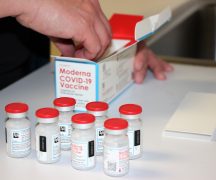After nearly 800,000 Ohioans have tested positive for COVID-19 since March, researchers say they’ve identified a homegrown and more infectious mutation of the coronavirus that causes COVID-19.
While the mutation is similar to a strain recently discovered in the United Kingdom and South Africa, researchers believe the “Columbus variant” originated in the U.S.
“We are now in a period where the virus is changing quite substantially,” said Dr. Dan Jones, who led the research team with the Ohio State University’s Wexner Medical Center.
Jones said the mutation in the spike protein of the coronavirus looks the same as those seen in the UK, albeit on top of a “locally derived backbone.” This means, if they are correct, the virus mutated in the U.S. and did not arrive in the country via international travel.
The findings have not yet been peer reviewed and Dr. Peter Mohler, another researcher on the team, warned against an overreaction. The researchers said they submitted their work to the Ohio Department of Health.
Both researchers said the findings are based on a limited number of isolated viral samples. They said they need to collect more data before they can determine exactly how much more easily spread the new mutation is. They found the suspected mutation via genomic sequencing of viral samples, a practice they hope to scale up in the coming weeks.
The U.K. is grappling with its own extra-spreadable mutation, driving up infection rates and yielding aggressive policy responses like travel restrictions and lockdowns.
The emergence of the suspected Columbus variant comes as about 8,000 Ohioans per day are contracting COVID-19. About 60 Ohioans per day died of COVID-19 in the last 10 days of 2020.
Although infection rates and the active number of Ohioans hospitalized with COVID-19 have decreased from their early-December peaks, they’re stable at a taxing level on the health care system.
All told, nearly 10,000 Ohioans have died from COVID-19. More than 42,000 have been hospitalized with the disease.
There’s cause for hope: Nearly 340,000 Ohioans have started the vaccination process (two doses taken 3-4 weeks apart) for the disease. Scarce supply has limited this to nursing home residents and staff, health care workers and certain first responders.
Next week, the Ohio Department of Health will broaden this to Ohioans aged 80 and older. The week of Jan. 25, vaccinations are anticipated for those 75 and up. The week of Feb. 1, vaccinations are anticipated for those 70 and up. The week of Feb. 8, vaccinations are anticipated for those 65 and up.
“Each county health department, in partnership with their local emergency management agency and vaccine providers, will communicate vaccine distribution plans with the media and the public on Wednesday and Thursday,” Gov. Mike DeWine said in a news release. “The process to vaccinate those in each county will vary depending on the provider. Some are expected to hold walk-up clinics, others may take appointments, etc.”
The OSU researchers said there is no evidence to suggest the vaccine is ineffective against the new mutation of the virus. Mohler said it’s “very likely” effective.
The key to preventing further mutations is simple in concept, thought as the last 10 months have proved, difficult with a haggard public, frenzied information (and misinformation) ecosystem, and toxic political culture.
“The less prevalent a virus is in the community, the less likely it is for a mutation to occur,” Jones said.





